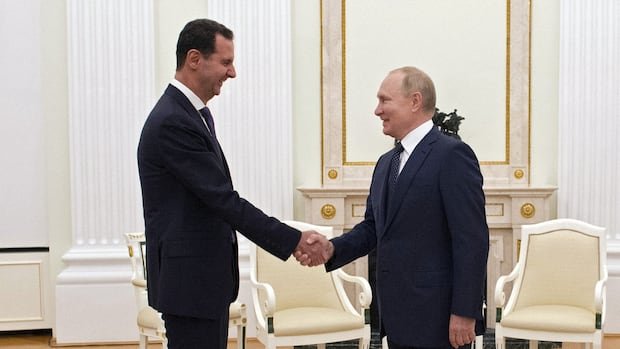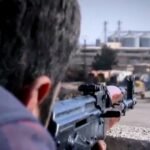Ousted Syrian President Bashar al-Assad said he had no plans to leave the country after the fall of Damascus a week ago, but the Russian military evacuated him after their base in western Syria came under attack.
The comments are Assad’s first since his overthrow by insurgent groups. Assad said in a statement on his Facebook page that he left Damascus on the morning of December 8, hours after insurgents stormed the capital. He said he had, in coordination with Russian allies, headed to the Russian base in the coastal province of Latakia, where he planned to continue fighting.
Assad said that after the Russian base was attacked by drones, the Russians decided to move it to Russia on the night of December 8.
“At no time during these events did I consider resigning or seeking refuge, nor was such a suggestion made by any individual or party,” Assad said in the English text of his statement. “The only option was to continue the fight against the terrorist attack.”

In Damascus, residents rejected Assad’s comments, with some saying he had abandoned the Syrian people long ago.
“Will he run away from us? He still won’t be able to run away from God,” said one resident, Moataz al-Ahmed, as children stepped on a toppled statue of Assad’s father Hafez, who began the terror attack that began the family’s half-century rule .
The spokesman for the Syrian interim government’s political department said in an interview on Monday that “the Assad regime is at an end without return” and Russia should “reconsider its presence on Syrian territory as well as its interests.”
Russia’s scorched-earth intervention on behalf of its ally Assad once turned the tide in the Syrian civil war. In 2017, Assad’s government signed a deal with Russia that offered it a free lease of both the Hmeimim air base and the Tartous naval base for 49 years.
Since Assad’s departure, there have been no clashes between Russian troops and the former rebels, who have suddenly become the de facto security forces for all of Syria. This is despite the fact that many of the fighters come from areas of northern Syria that have been frequently bombed by Russia and have little love for Moscow.
A week after the fall of Bashar al-Assad, a Damascus suburb is still reeling from the brutality and terror of the Assad regime.
A fighter guarding the closed civilian airport next to the Hmeimim base said Monday: “The Russians are preparing to withdraw from Syria, God willing.” He gave only his nickname, Abu Saif, because he was not authorized to to express themselves publicly.
Russian forces have withdrawn from some areas of Syria. On Friday, Russian forces and military vehicles were seen withdrawing from southern Syria towards their main base in the city of Latakia.
While Putin granted Assad and his family asylum in Russia, Moscow turned to the new Syrian authorities to ensure the security of its bases and extend the stay of its troops. Instead of the two-star flag of the old government, the three-star flag of the Syrian revolution was quickly hoisted at the Syrian embassy in Moscow.
Obstacles to building Syrian relations
Meanwhile, the European Union’s top diplomats said on Monday they are demanding guarantees from members of Syria’s interim government that they are preparing for a peaceful political future inclusive of all minority groups, in which extremism and former allies Russia and Iran have no place.
Since Assad’s fall, few reports of reprisals, revenge killings or sectarian violence have emerged. Most of the looting or destruction was quickly contained.
Syria is home to numerous ethnic and religious communities that are often pitted against each other by the Assad state and years of war. Many of them fear the possibility of Sunni Islamist extremists coming to power.
But the new leadership does not yet have a clear idea of how Syria should be governed. The interim government was installed by former opposition forces led by the Islamist militant group Hayat Tahrir al-Sham (HTS), a former EU and US al-Qaeda affiliate and Canada considered a terrorist organization.
The interim government is expected to rule until March. Arab foreign ministers have called for UN-supervised elections based on a new constitution. The UN envoy for Syria has pushed for sanctions to be lifted.
Front burner26:42The end of the Assad regime in Syria
In order to understand more, the EU is sending an envoy to Damascus for talks with those responsible, at least temporarily.
EU foreign policy chief Kaja Kallas said the bloc wanted a “stable, peaceful and all-inclusive government” but it would likely take weeks, if not months, for Syria’s new path to become clear.
“For us it’s not just the words, we want to see the actions,” she said.
Syria has been rocked by five decades of rule by the Assad family. The economy is devastated, poverty is widespread, inflation and unemployment are high, and corruption permeates daily life. Millions of people have fled the country.
Hundreds of thousands of them live in Europe, and while some EU countries have suspended Syrian refugees’ asylum applications, for now only those willing to return are being helped to return home.
In 2011, the EU began freezing assets and imposing travel bans on Syrian officials and organizations in response to Assad’s crackdown on civilian protesters, which spiraled into civil war. The sanctions were imposed on some 316 people and 86 organizations accused of supporting Assad.
Additionally, a Britain-based war monitor said Israeli airstrikes hit missile sites in Syria early Monday, calling them the “most violent attacks” since 2012. Israel has reportedly struck military sites in Syria following the dramatic collapse of Assad’s rule. The air defenses and most of the former Syrian army’s arsenal were wiped out.
Israeli troops have also seized a border buffer zone, prompting condemnation. Critics accused Israel of violating the 1974 ceasefire and possibly exploiting the chaos in Syria for a land grab.






